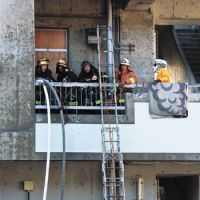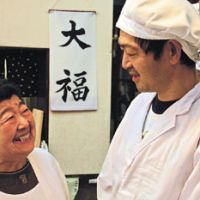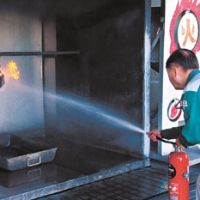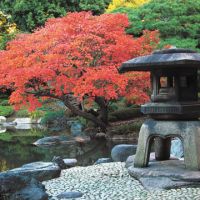Burning to see fall colors, I head to Tokyo's northern Kita Ward, where Kyu Furukawa Teien, the former estate of copper magnate Ichibei Furukawa, features not only a traditional Japanese garden but also Western-style flowerbeds of autumn-blooming roses. At this time of the season, it should be ablaze.
Emerging from the Nanboku Line's Nishigahara Station, I find myself facing the National Printing Bureau's Takinogawa Plant, where most of Japan's paper currency notes are produced. The security guards and I chat about some of the features — hand-applied holograms, latent images, tactile intaglio, etc. — employed in making Japan's banknotes counterfeit-proof. "Can I take a peek inside?" I ask. The guards laugh. "Yeah, we'd all like to just stroll in and look around," one guard says, smirking. Since the plant is off limits even to the security detail, I judge my chances nil, and move on.
Two minutes later, a man standing outside a semi-cylindrical building waves me over. He thinks I have arrived for a group tour of the Earthquake Science Center. I haven't, but Tokyo news has been full of quake warnings recently, so finding the facility open to the public, I pop in.
The museum's first display is a lifesize model of a post-quake traditional Japanese kitchen; it features interior design by Godzilla, with broken glass and smashed electrical appliances. Other museum exhibits have the unassuming aura of science-fair projects, depicting Japan's earthquake history, tectonic plates and techniques for stabilizing furniture. Finally, video testimonials by victims of the recent Great East Japan Earthquake brings immediacy to the subject.
The museum includes a facility across from the main hall. There, like a bad "Let's Make a Deal" show, I find three small rooms all lined up, meant to simulate a Japanese house. "Choose one," I am instructed, so I doff my shoes and settle in the tatami room of what I now realize is an earthquake simulator.
The operator starts me out with a shindo 4 (intensity 4) on the Japanese scale of 0-7. The light fixture overhead swings, the floor starts to sway and then buck, and I slide a bit on the tatami floor. The operator nods, and stops. "Now better get a pillow over your head," he warns me. I do, and then he jacks up the contraption to a 7, as high as the machine goes, and it becomes impossible to remain seated. I am pretty much stretched out like a lizard when the operator asks if I'd like to undergo the Great Kanto Earthquake of 1923 that shook Tokyo for more than 4 minutes. I respectfully decline, plenty joggled, thank you.
I am joined by museum guide, 60-year-old Toshio Chiba, who offers to let me experience being trapped in a fire, where I'll have to crawl to safety below noxious smoke layers ("propylene glycol, so not to worry," he says). Worried, nonetheless, that this might be as realistic as the earthquake rooms, I opt to get smoked another day.
But Chiba is still hot to trot. We climb three flights of stairs to the museum's rooftop Fire Extinguisher Training area. Chiba deftly suspends an oil-soaked brick from a metal rod, and lights it on fire. We practice the proper extinguishing drill: hoist canister, run to fire, pull pin, point hose and squeeze lever. Our brick blazes on, though, because the extinguishers at the museum are loaded with water. "It takes four water extinguishers focused all at once to put out the brick," Chiba says, snuffing it with a stash of the pink powder usually inside the red cans.
Glancing over the neighborhood from my bird's-eye vantage, I spy below a scene that seriously mocks our extinguishing prowess. Thanking Chiba for his lesson, I fly down the stairs and speed over to what turns out to be the Takinogawa Fire Station. Sidling up to a bay of gleaming cherry-red fire trucks, I wonder how to get around to the back, where I saw some major hoses at work.
Inquiring at the reception desk, the sweetest fireman on the planet runs me upstairs to fill out the required official forms for a visit. Getting the OK from the Tokyo headquarters, I head downstairs to watch the Takinogawa training facilities in action.
The guys assigned to make sure I don't end up toast, Chief Yoshiaki Matsubara, 38, and Manabu Shibue, 28, first ask me if I'd like to get into some firemen's pants. Before I can reply, I'm presented with an entire bokai (firefighter's outfit) to put on.
Somehow, inside seconds, these men have worked out my size perfectly. I realize, stepping into the comfy boots with turnout pants attached, one is meant to get this kit on quickly; so I yank up the pants, use pull-strings to close the boots, and slap shut the Velcro fly. The jacket, however, is a whole different load. It has mega-buckles and a radio, an air tank and regulator, plus reinforced mask, and it brings the ensemble to nearly 20 kg. "That," Matsubara says as I wobble about and strike Ultraman poses, "is without the saw, helmet, lantern and hose. The total gear can add up to 40 kg. Plus, in the summer, we tuck ice packs inside the suit." And then, with all that, firemen still heft people to safety? Respect!
Back in my civvies, I hit the training grounds in time to see the Iidabashi Fire Department arrive at the seven-story Takinogawa facility for an all-hands timed drill. From the word go, men shout and radios squawk as a tightly choreographed siege on the "fire" begins. Ladders are thrown, hoses deployed, and firefighters, both male and female, make fire-bucket rescues from the upper floors. The air crackles with tension as the Iidabashi Fire Chief paces the scene, air tanks whistle eerie warnings of low supply, and men carry weighted rescue dummies through the spray. I'm ablaze with admiration and watch until the last hose is repacked before thanking Chief Matsubara and Shibue for the impressive exhibition.
Heading south again, I'm suddenly ravenous. Luckily, I happen upon small dango (skewered rice dumplings) shop Hiratsukatei Tsuruoka. There, Yaeko Tsuruoka, 88, her daughter Ikuko, 62, and son Tokuya, 48, serve up slightly salty daifuku mochi (rice cakes filled with bean paste), awamochi (rice and millet cakes) and of course dango, just as Yaeko's grandfather did back before World War II, when the shop was a humble rest stop for visitors to the nearby shrine. "For ¥2, people who walked here could take a break, drink tea and eat treats," Yaeko says, "and that's how the business began."
I order a skewer of dango, and find the sauce light and savory, and the taste of the grilled crust on the rice more pronounced than usual. It's fabulous. Between banter with customers, Yaeko boasts that her shop has appeared on two TV shows and also in books. "Plus," Tokuya chimes in, "our ingredients are of the absolute highest quality and, whenever possible, local."
Satiated, I bid the Tsuruokas farewell and go explore the Hiratsuka Shrine behind their shop. Dating from the late Heian Period (ca. 1100s), the shrine takes its name from a hiratsuka (flat mound) under which lies the armor of famous warrior Minamoto no Yoshiie (1039-1106), presented as a gift to locals in gratitude for their hospitality. I leave only a few coins, and set off again.
Finding the entrance to Kyu Furukawa Teien, I pay the ¥150 entrance fee, and then Service Center head Sachiko Hori accompanies me as I walk around the imposing andesite-clad home and through sculpted rose gardens, both designed by British architect Josiah Condor (1852-1920). We breathe in the thick fragrance of lush blossoms at the garden's edge, peering down into a dark abyss. There is no indication from this upper plateau that below there stretches out a Japanese garden by Kyoto native Jihei Ogawa (1860-1933), often referred to as the "genius of water and stone."
Hori and I descend through a tunnel of maples and the landscape opens out on a pond shaped like the Japanese character for "heart." Here and there, trees have turned sanguine shades and autumn light caresses the garden's astounding collection of lanterns and its two teahouses. Hori explains to me as we walk that the land here once belonged to Munemitsu Mutsu (1844-1897) a Meiji Era diplomat who relinquished his lands when his second son was adopted into the Furukawa family.
Today, the Furukawa house has been lovingly restored and is managed by the Otani Art Museum. Hori introduces me to manager Junichi Suzuki, who allows me to admire the carved plaster ceilings and massive fireplace in the main dining room, as well as the intimate warmth of the second-floor Japanese rooms. The house, much like the gardens, graciously spans two cultural esthetics.
Outside once again, I chat with estate gardener Akiyasu Tagashira, 45, as he hand-fashions yukisturi (snow protectors) for the garden. "These aren't actually functional because we don't get much snow here," Tagashira says. "But they are integral to the garden's seasonal character." Tagashira compares his work on Ogawa's garden to that of raising a child. "After eight years, I've just begun to grasp its depth," he says, soaking twine in sumi ink to strengthen it before tying the tops of the yukitsuri.
It is now dusk. Sun underlines clouds in pink and wind scatters leaves. As I depart, I glance back at the estate's small concession stand selling rose-petal ice cream, soon to close as the season's fires slowly burn themselves out.
Entrance to the Furukawa residence can be reserved only by return postcard through the Otani Art Museum and costs ¥525. Kit Nagamura wishes all happy holidays and will take a break during December, resuming Backstreet Stories once again in January 2013.






